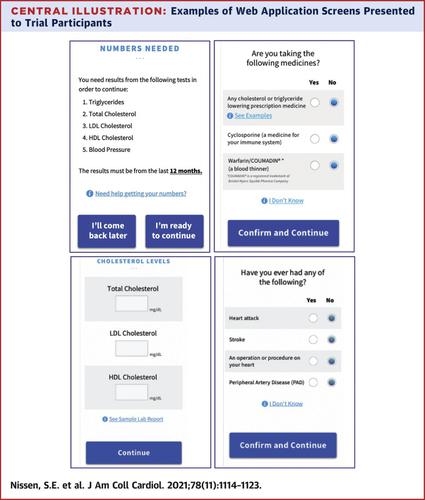Journal of the American College of Cardiology ( IF 24.0 ) Pub Date : 2021-09-06 , DOI: 10.1016/j.jacc.2021.06.048 Steven E Nissen 1 , Howard G Hutchinson 2 , Tracy Y Wang 3 , Christie M Ballantyne 4 , Sara Travis 5 , Melanie Morris 2 , William Miller 5 , Jennifer Hynson 5 , Kathy Wolski 1 , Paul M Ridker 6

|
Background
Although statins reduce cardiovascular morbidity and mortality, only about one-half of eligible patients receive treatment. Safe and appropriate consumer access to statins could have a significant positive public health impact.
Objectives
This study compares the concordance between a participant and clinician assessment of eligibility for statin therapy using a technology-assisted approach.
Methods
A total of 500 participants, 83 with limited literacy, completed an at-home Web-based application to assess appropriateness for treatment with rosuvastatin 5 mg. The Web application is designed to assess eligibility for a moderate-intensity statin based on current guidelines and deny access to individuals with contraindications to rosuvastatin. Subsequently, participants visited a research site where clinicians, blinded to the information the participant entered, performed an independent Web application assessment. The Web application is programmed for 1 of 3 rosuvastatin treatment outcomes: “OK to use,” “not right for you,” or “ask a doctor.” The primary endpoint was the percent of participants whose self-selected eligibility for nonprescription rosuvastatin was concordant with clinician assessment.
Results
For the primary endpoint, participant selection for statin therapy was concordant with clinician selection in 481 (96.2%) of 500 participants (95% confidence interval: 94.1%-97.7%), of whom 23 (4.6%) were deemed appropriate and 458 (91.6%) were deemed inappropriate for treatment. Discordance was due to incorrect self-selection (“OK to use”) in 3 cases, incorrect rejection (“not right for you”) in 14 cases and an incorrect “ask a doctor” outcome in 2 cases.
Conclusions
The use of a technology-assisted approach to consumer self-selection for statin therapy resulted in participant self-selection that showed substantial agreement with clinician selection.
中文翻译:

非处方他汀类药物治疗候选者的技术辅助自我选择
背景
尽管他汀类药物可降低心血管发病率和死亡率,但只有约二分之一符合条件的患者接受治疗。安全和适当的消费者获取他汀类药物可能会对公共健康产生重大的积极影响。
目标
本研究比较了参与者和临床医生使用技术辅助方法评估他汀类药物治疗资格的一致性。
方法
共有 500 名参与者(其中 83 名识字率有限)完成了一项基于网络的家庭应用程序,以评估瑞舒伐他汀 5 mg 治疗的适宜性。该 Web 应用程序旨在根据当前指南评估中等强度他汀类药物的资格,并拒绝有瑞舒伐他汀禁忌症的个人使用。随后,参与者访问了一个研究站点,在那里临床医生对参与者输入的信息不知情,进行了独立的 Web 应用程序评估。该 Web 应用程序针对 3 种瑞舒伐他汀治疗结果中的一种进行了编程:“可以使用”、“不适合您”或“请教医生”。主要终点是自选的非处方瑞舒伐他汀资格与临床医生评估一致的参与者百分比。
结果
对于主要终点,他汀类药物治疗的参与者选择与 500 名参与者中的 481 名 (96.2%) 的临床医生选择一致(95% 置信区间:94.1%-97.7%),其中 23 名(4.6%)被认为是合适的,458 名( 91.6%) 被认为不适合治疗。不一致是由于 3 例不正确的自我选择(“可以使用”),14 例不正确的拒绝(“不适合你”)和 2 例不正确的“问医生”结果。
结论
使用技术辅助方法进行他汀类药物治疗的消费者自我选择导致参与者自我选择与临床医生选择基本一致。



























 京公网安备 11010802027423号
京公网安备 11010802027423号